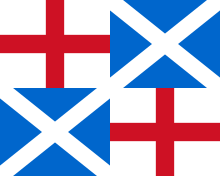Commonwealth of England

Commonwealth of England was the official name of the English Republic from 1649 to 1660. The Commonwealth initially only comprised England (including Wales ), then Scotland and Ireland as well .
history
At the end of the English Civil War from 1642 to 1648, King Charles I was executed on January 30, 1649 . Almost four months later, on May 19 of the same year, the Commonwealth was introduced with the Act declaring England to be a Commonwealth . From the beginning, Oliver Cromwell , a leader in the Civil War, had excelled. He put down royalist uprisings in Ireland (1649) and Scotland (1650/51) . The Commonwealth had neither an upper house nor a king , the lower house became the sole " Parliament of England ". The three highest dignitaries were the Speaker of the Parliament, the President of the Army and the Council of State. This council held the government and was appointed by parliament.
The instrument of government introduced in April 1653 put Oliver Cromwell at the head of the State Council. He dissolved the rump parliament and now called himself "Lord President". After the short-lived " Parliament of the Saints " dissolved, he took over the legislature alone as " Lord Protector " .
He refused the royal dignity offered to him in 1657 with the constitutional charter "Humble Petition and Advice" and remained lord protector until his death in 1658. His son Richard Cromwell took over the title of Lord Protector. But he could not prevail and abdicated on May 25, 1659. From now on the parliament ruled again.
In 1660, George Monck dissolved parliament and established a new one that was loyal to the king. On May 8, 1660, the MPs proclaimed Charles II , the son of the executed Stuart king, Charles I, as king, thereby ending the time of the Commonwealth of England. Charles II returned to London from his exile on May 29, 1660 and took control of the country. His coronation did not take place until April 23, 1661 at Westminster Abbey .
Commonwealth was also used as a country name by various British ex-colonies, still today by Australia ( Commonwealth of Australia , German "Australian Federation") and by four states of the USA .
See also
swell
literature
- William Godwin : History of the Commonwealth of England. 4 volumes, H. Colburn, London 1824–28 (volumes 1 , 2 , 3 , 4 at archive.org).
Web links
- "British History Timeline" of the BBC (Flash animation, English)



